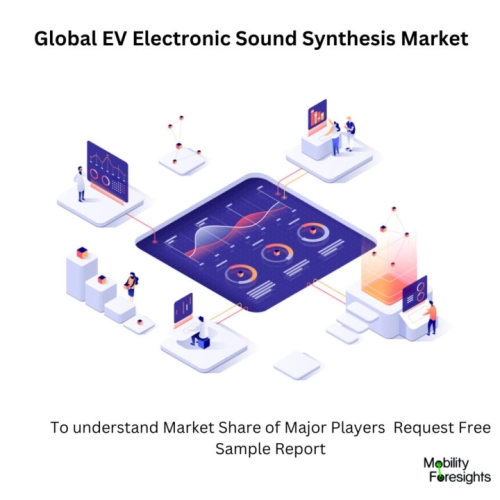
- Get in Touch with Us

Last Updated: Apr 25, 2025 | Study Period: 2023-2030
EV electronic sound synthesis is a type of sound synthesis that combines natural-sounding acoustic instruments with synthesised sounds. Unlike traditional analog synthesis, which relies on analog circuits to create a wide range of sounds.
EV electronic sound synthesis uses digital signal processing (DSP) technology to create sound from a variety of sources. Examples of these sources include samples from acoustic instruments, pre-recorded sounds, and virtual instrument patches.
The technology behind EV electronic sound synthesis is based on the concept of additive synthesis. This process involves combining multiple waveforms to create a complex sound.
By manipulating the waveforms, the user can alter the tone, timbre, and even the pitch of the sound. The result is a much more lifelike sound than is possible with traditional analog synthesis.
EV electronic sound synthesis also allows for a greater degree of control over the parameters of the sound.
With the use of a graphical user interface (GUI), users can easily adjust the soundâs envelope, filter, and modulation characteristics. Additionally, the user can access a wide range of effects, such as reverb, chorus, and delay, to further shape the sound.
EV electronic sound synthesis is used in a variety of musical applications, from live performances to studio recordings. It is also used in video game soundtracks, television and film scores, and other multimedia projects. The flexibility of the technology allows for a wide range of sounds, from realistic acoustic instruments to entirely synthetic sounds.

The Global EV electronic sound synthesis market accounted for $XX Billion in 2022 and is anticipated to reach $XX Billion by 2030, registering a CAGR of XX% from 2023 to 2030.
HARMAN HALOsonic® launched an electronic sound synthesis system. Rich automotive sound, whether it comes from the interior or the outside, is a fundamental component of driving and helps to define the character of a car.
This is particularly true if OEMs employ turbochargers and smaller engines to cut emissions and fuel consumption, which might result in a reduction in engine sound. Furthermore, electric and hybrid cars lack input on speed and acceleration a crucial component of a thrilling driving experience because their powertrains are silent.
When approaching electric or hybrid vehicles, pedestrians, cyclists, and other road users who are used to depending on auditory cues from automobiles may miss them.
To address these problems and enable OEMs to achieve the desired engine sounds representative of their brand identity, HARMAN HALOsonic® Electronic Sound Synthesis systems offer internal Electronic Sound Synthesis (iESS) and exterior Electronic Sound Synthesis (eESS) allowing the regular speaker system to produce sounds that are based on speed, acceleration, and throttle, enabling sound contouring inside the vehicle.
With today's electric and hybrid vehicle applications, "coloring the blank acoustic canvas" in "all-electric" mode is entirely flexible thanks to advanced synthesis tools.
In hybrid or range-extended electric vehicles, sound synthesis during engine-off conditions enhances the perception of engine start-stop events. Drivers feel more connected to the vehicle they drive because of improved powertrain feedback.
| Sl no | Topic |
| 1 | Market Segmentation |
| 2 | Scope of the report |
| 3 | Abbreviations |
| 4 | Research Methodology |
| 5 | Executive Summary |
| 6 | Introdauction |
| 7 | Insights from Industry stakeholders |
| 8 | Cost breakdown of Product by sub-components and average profit margin |
| 9 | Disruptive innovation in theIndustry |
| 10 | Technology trends in the Industry |
| 11 | Consumer trends in the industry |
| 12 | Recent Production Milestones |
| 13 | Component Manufacturing in US, EU and China |
| 14 | COVID-19 impact on overall market |
| 15 | COVID-19 impact on Production of components |
| 16 | COVID-19 impact on Point of sale |
| 17 | Market Segmentation, Dynamics and Forecast by Geography, 2023-2030 |
| 18 | Market Segmentation, Dynamics and Forecast by Product Type, 2023-2030 |
| 19 | Market Segmentation, Dynamics and Forecast by Application, 2023-2030 |
| 20 | Market Segmentation, Dynamics and Forecast by End use, 2023-2030 |
| 21 | Product installation rate by OEM, 2023 |
| 22 | Incline/Decline in Average B-2-B selling price in past 5 years |
| 23 | Competition from substitute products |
| 24 | Gross margin and average profitability of suppliers |
| 25 | New product development in past 12 months |
| 26 | M&A in past 12 months |
| 27 | Growth strategy of leading players |
| 28 | Market share of vendors, 2023 |
| 29 | Company Profiles |
| 30 | Unmet needs and opportunity for new suppliers |
| 31 | Conclusion |
| 32 | Appendix |